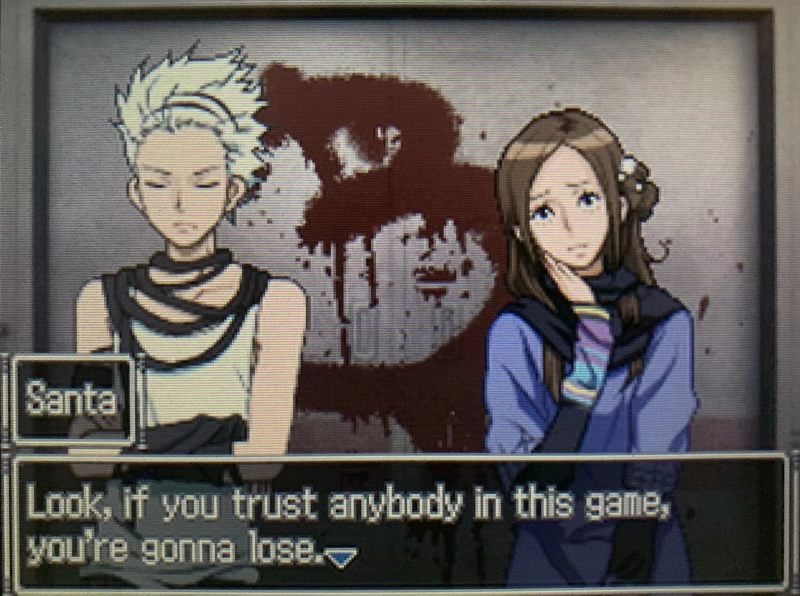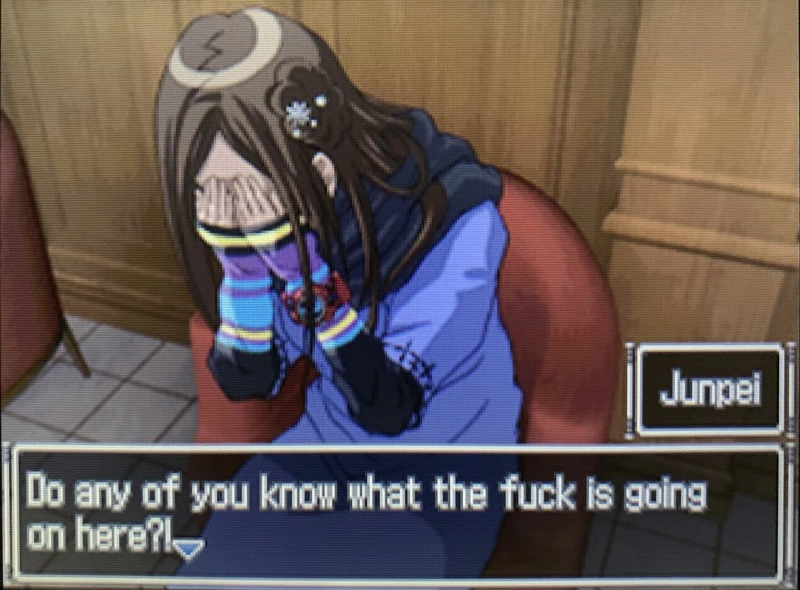by Dan McAlister

Score: 4/5
Platforms: Nintendo DS, or bundled with its sequel as Zero Escape: The Nonary Games for PS4, PS Vita, and Windows.
Back in 2012, there was a big uproar around the endings of Mass Effect 3. This was the capstone to a trilogy that emphasized how the player’s choices shaped the narrative, but when the third game released, the available endings prompted outrage for not accurately reflecting the meaningful choices each player made along the way. Even the Better Business Bureau weighed in. The argument, it seemed, was that the story’s poor conclusion invalidated the player’s experience with the game.
I dislike this. Endings have value, but they’re not the only thing in a game or in a story that has value. And in games with branching narratives like the Mass Effect games, a focus on getting “the perfect” ending shifts attention away from the meaning of these choices in the moment. Besides, if I’m going to put dozens of hours into a trilogy like Mass Effect, I would hope that my enjoyment of the experience doesn’t hinge entirely on the last 20 minutes.
This is why I approached Nine Hours, Nine Persons, Nine Doors with skepticism. It’s a mystery thriller game that has multiple endings, but I had also heard it had a “true ending” that you could only experience after seeing other, false endings. Is the game saying the only valid experience is the one with the “true” ending? Will it knowingly put me through poorer versions of the story before allowing me to see the “best” version? I was not thrilled.
But I played the game, and I replayed it, again and again, and I got the true ending. And I was stunned. Not because the true ending blew my mind (more on that later), but because finding that true ending required me to study and better understand the journey I was having. Even the dead ends I hit were valuable, teaching me more about a mystery that couldn’t be understood from a single experience. Nine Hours, Nine Persons, Nine Doors isn’t perfect, but it is special, and what it gets right is central to its atypical structure.

You play as Junpei, a college student who gets kidnapped by a madman named Zero. He wakes up in a passenger cabin aboard a sinking cruise ship and is forced to play a dangerous “Nonary Game” with eight other people. The vessel is filled with doors emblazoned with big red numbers, and if the nine people can’t find the number nine door within nine hours, they’ll be dragged down with the ship. Also, they’re all wearing numbered bracelets, and they all have bombs in their bodies that will detonate if they break the rules. What follows is a lot of sleuthing, puzzling, drama, and math.
The game splits itself between two genres. Behind each of the ship’s numbered doors are escape room-style puzzles that play out like classic point-and-click adventures in miniature. Junpei and his comrades pick through passenger cabins, kitchens, recreational areas and cargo holds for keys that will grant access to more of the ship, as well as clues and puzzles that will get them out of the given locked room. In between these escape room sections are extended scenes of visual novel narration and dialogue, as well as some major decisions for the player. The numbered doors act as forks in the narrative: if the five door and four door are next to one another, choosing the five door means not seeing what is past the four door. You don’t know where the doors lead, it’s a shot in the dark. Furthermore, the numbered doors only accept certain combinations of characters based on how their numbered bracelets add up with one another.

Dilemmas like choosing doors frequently throw the characters into conflict, and it turns out that being locked in a death trap provokes a lot of conversation. When the group finds a set of three new numbered doors, the character Lotus suggests leaving someone behind. It’s out of left field, but it comes from a place of logic: Lotus has already done the math for these doors, and there’s no combination of doors and party members that would get everyone through to the next area. Meanwhile, June compassionately argues they should keep searching for alternatives, that maybe there’s information they’re unaware of. Scenes like this pull an already tense situation even tighter, and underscore the deadly atmosphere of the ship itself.
While big group conversations often spur conflict and debate, the smaller escape room sections provide opportunities for quiet, one-on-one dialogue with the few characters able to accompany you. Sometimes it’s as simple as a character remarking that a puzzle reminds them of a rare medical condition, and other times it’s a deep dive into a traumatic experience in a character’s past. The scenes in these escape rooms show more vulnerability, allowing characters to open up about their lives, and you begin to connect the dots on why these specific people were brought onto this ship.

The puzzles in the escape rooms are well thought out and intuitive. They require exploration and critical thinking, but I never felt as completely stuck as I did in classic point-and-click adventure games. These challenges vary from figure-out-the-right-piano-melody charming to strap-someone-in-an-electric-chair creepy, and they beg a constant question: why are we being put through these weird puzzles on this death trap ship?
That question wasn’t answered when I hit my first ending after a few hours of play. The game told me it was a “BAD ENDING,” which was gruesomely obvious from the events that played out. But that first ending I witnessed was thrilling, and left me with many more questions. I dove back in to start from the beginning and pass through some different doors.
Each time you play through the game, Junpei wakes up in the same cabin and has to do the same puzzles. This is one of the major weak points of Nine Hours, Nine Persons, Nine Doors; doing the same puzzle, again and again when you already know the solution, just isn’t fun. It feels like a huge design oversight, made even more baffling for the fact that the game’s menu allows you to replay puzzles in isolation after you beat them the first time. Who wants to do that? Do yourself a favor: write down the trickier, math-heavy puzzle solutions after you first do them. I ended up doing most of the game’s puzzle rooms at least twice, and it was never, ever fun the second time around. But if you keep track of which items are found where, how they’re used, and what to put into certain keypads, you can blow through these rooms in minutes.
The narrative sections fare better on the replay, because the game lets you fast-forward through text you’ve already read. The fast-forward feature will automatically halt any time you hit new dialogue or a choice that allows you to pursue a new narrative path, such as passing through a different numbered door than before. But still, it’s fast-forwarding rather than skipping; on my second play-through, it took me almost fifteen minutes to get from the start of the game to the first decision that would branch the narrative toward a new direction. That meant a lot of time holding down the fast-forward button, and my thumb didn’t appreciate it.
But keeping track of puzzle solutions and speeding through dialogue did accelerate the process, and I hit my second ending, also BAD, much faster. At this point, I was curious; the story was involving, the atmosphere creepy and dangerous, but the experience felt arbitrary since I didn’t have any information to inform those choices, I didn’t see a reason to choose one door over another. I felt less like a detective solving a mystery and more like a wanderer without a map.

But as I kept playing, kept testing new choices, my perspective changed. As I learned more about the outcomes of individual choices, my decisions became more informed. Actually, there is a reason to choose this door over that door. There is a way to anticipate that bad outcome, and to stop it. Fast-forwarding through text felt different, like flying through a record of what had happened, understanding it differently. There’s a reason that Nine Hours, Nine Persons, Nine Doors can’t be understood from a single experience, and that reason is central to the mystery itself.
I found the True Ending on my sixth play-through, and I didn’t stumble across it. I figured out where it was, how to get there, and why those steps mattered. And while any game or story is more than its ending, an ending can alter your perspective and color your understanding of the experience that came before it. This is one of those endings, and in the interest of preserving surprise I won’t spoil it. But I will say this: the true ending of Nine Hours, Nine Persons, Nine Doors, the answer at the heart of the game’s deadly mystery, is silly. It is very silly. It is silly in ways that made me smile and silly in ways that scooped out the game’s careful, deadly tension and plopped it limp onto the ground. The ending is a mixed bag.
But Nine Hours, Nine Persons, Nine Doors is fortunately much more than its ending. It’s a unique, clever puzzle that plays best with a pile of notes and diagrams. It rewards careful attention and understanding its characters. It’s an ambitious trip that doesn’t quite nail the landing, but I’m still thankful for the experience I had getting there.
Pilediver is a review series where I play through the many, many games in my backlog. Thank you for reading.
The opinions in this post are expressly the views of the author and do not reflect the views of their employer(s) or any entities that they might otherwise be affiliated.